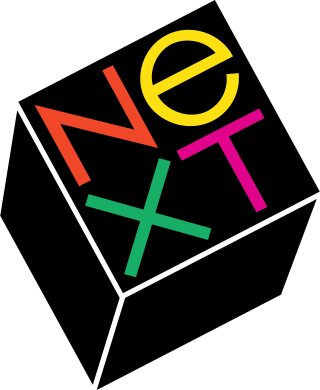Related Research Articles

Apple Inc. is an American multinational technology company headquartered in Cupertino, California. As of March 2023, Apple is the world's largest company by market capitalization, and with US$394.3 billion the largest technology company by 2022 revenue. As of June 2022, Apple is the fourth-largest personal computer vendor by unit sales; the largest manufacturing company by revenue; and the second-largest mobile phone manufacturer in the world. It is considered one of the Big Five American information technology companies, alongside Alphabet, Amazon, Meta, and Microsoft.

NeXT, Inc. was an American technology company headquartered in Redwood City, California that specialized in computer workstations for higher education and business markets, and later developed web software. It was founded in 1985 by CEO Steve Jobs, the Apple Computer co-founder who had been forcibly removed from Apple that year. NeXT debuted with the NeXT Computer in 1988, and released the NeXTcube and smaller NeXTstation in 1990. The series had relatively limited sales, with only about 50,000 total units shipped. Nevertheless, the object-oriented programming and graphical user interface were highly influential trendsetters of computer innovation.

The Power Macintosh, later Power Mac, is a family of personal computers designed, manufactured, and sold by Apple Computer, Inc as the core of the Macintosh brand from March 1994 until August 2006.

Microsoft PowerPoint is a presentation program, created by Robert Gaskins and Dennis Austin at a software company named Forethought, Inc. It was released on April 20, 1987, initially for Macintosh computers only. Microsoft acquired PowerPoint for about $14 million three months after it appeared. This was Microsoft's first significant acquisition, and Microsoft set up a new business unit for PowerPoint in Silicon Valley where Forethought had been located.

Taligent Inc. was an American software company. Based on the Pink object-oriented operating system conceived by Apple in 1988, Taligent Inc. was incorporated as an Apple/IBM partnership in 1992, and was dissolved into IBM in 1998.

John Sculley III is an American businessman, entrepreneur and investor in high-tech startups. Sculley was vice-president (1970–1977) and president of PepsiCo (1977–1983), until he became chief executive officer (CEO) of Apple Inc. on April 8, 1983, a position he held until leaving in 1993. In May 1987, Sculley was named Silicon Valley's top-paid executive, with an annual salary of US$10.2 million.

The Macintosh LC is a family of personal computers designed, manufactured and sold by Apple Computer, Inc. from 1990 to 1997.

Guy Takeo Kawasaki is an American marketing specialist, author, and Silicon Valley venture capitalist. He was one of the Apple employees originally responsible for marketing their Macintosh computer line in 1984. He popularized the word evangelist in marketing the Macintosh as an "Apple evangelist" and the concepts of evangelism marketing and technology evangelism/platform evangelism in general.

MacLife is an American monthly magazine published by Future US. It focuses on the Macintosh personal computer and related products, including the iPad and iPhone. It was sold as a print product on newsstands, but is now exclusively a digital–only product distributed through Magazines Direct, or through the Mac|Life app which can be obtained via the App Store. Between September 1996 and February 2007, the magazine was known as MacAddict.

AppleWorks was an integrated office suite containing a word processor, database, and spreadsheet. It was developed by Rupert Lissner for Apple Computer, originally for the Apple II platform and launched in 1984. Many enhancements for AppleWorks were created, the most popular being the TimeOut series from Beagle Bros which extended the life of the Apple II version of AppleWorks. Appleworks was later reworked for the Macintosh platform.

Andrew Jay Hertzfeld is an American software engineer and innovator who was a member of the original Apple Macintosh development team during the 1980s. After buying an Apple II in January 1978, he went to work for Apple Computer from August 1979 until March 1984, where he was a designer for the Macintosh system software. Since leaving Apple, he has co-founded three companies: Radius in 1986, General Magic in 1990, and Eazel in 1999. In 2002, he helped Mitch Kapor promote open source software with the Open Source Applications Foundation. Hertzfeld worked at Google from 2005 to 2013, where in 2011, he was the key designer of the Circles user interface in Google+.

Susan Kare is an American artist and graphic designer, who contributed interface elements and typefaces for the first Apple Macintosh personal computer from 1983 to 1986. She was employee #10 and Creative Director at NeXT, the company formed by Steve Jobs after he left Apple in 1985. She was a design consultant for Microsoft, IBM, Sony Pictures, Facebook, and Pinterest. As of 2007 Kare was an employee of Niantic Labs. As a pioneer of pixel art and of the graphical computer interface, she has been celebrated as one of the most significant designers of modern technology.
WebMD is an American corporation which publishes online news and information about human health and well-being. The WebMD website also includes information about drugs and is an important healthcare information website and it is the most popular consumer oriented health site.
Bruce "Tog" Tognazzini is an American usability consultant and designer. He is a partner in the Nielsen Norman Group, which specializes in human-computer interaction. He was an early employee of Apple Computer, staying with the company for fourteen years, then he was with Sun Microsystems for four years, then WebMD for another four years.
The Apple community is a group of people interested in Apple Inc. and its products, who report information in various media. Generally this has evolved into a proliferation of websites, but latterly has also expanded into podcasts, either speculating on rumors about future product releases, simply report Apple-related news stories, or have discussions about Apple's products and how to use them.

Apple Inc., originally named Apple Computer, Inc., is a multinational corporation that creates and markets consumer electronics and attendant computer software, and is a digital distributor of media content. Apple's core product lines are the iPhone smartphone, iPad tablet computer, and the Macintosh personal computer. The company offers its products online and has a chain of retail stores known as Apple Stores. Founders Steve Jobs, Steve Wozniak, and Ronald Wayne created Apple Computer Co. on April 1, 1976, to market Wozniak's Apple I desktop computer, and Jobs and Wozniak incorporated the company on January 3, 1977, in Cupertino, California.
Hayden Book Company was an imprint of MacMillan Computer Publishing USA that published computing books, with a particular emphasis on the Macintosh platform and desktop design. Video games and educational software for home computers, such as Championship Golf, Sargon II, and Sargon III, were published as Hayden Software.

SuperPaint is a graphics program capable of both bitmap painting and vector drawing. SuperPaint was one of the first programs of its kind, combining the features of MacPaint and MacDraw while adding many new features of its own.

Apple Inc. has designed and manufactured several models of mice, trackpads, and other pointing devices, primarily for use with Macintosh computers. Over the years, Apple has maintained a distinct form and function with its mice that reflect their design languages of that time. Apple's current external pointing devices are the Magic Mouse 2 and Magic Trackpad 2.

Northern & Shell is a British publishing group, founded in December 1974 and owned since then by Richard Desmond. Formerly a publisher of pornographic magazines including Penthouse and Asian Babes, it published the Daily Express, Sunday Express, Daily Star and Daily Star Sunday, and the magazines OK!, New! and Star until these were sold to Trinity Mirror in February 2018. Northern & Shell also owned three entertainment television channels: Channel 5, 5* and 5USA until 2015. It owned Portland TV, which operates pornographic TV channels including Television X and Red Hot TV; the company sold Portland in April 2016.
References
- 1 2 3 "Impress Group Company Profile" (PDF). Impress Group Company. 2016. Retrieved 3 November 2016.
- ↑ The InDesign Conference: Tokyo: September 12th - 13th, 2007 , retrieved 13 November 2007
- ↑ Vidyadharan, Aravind (1 June 1993). "MdN's grand design". South China Morning Post. Retrieved 30 June 2023.